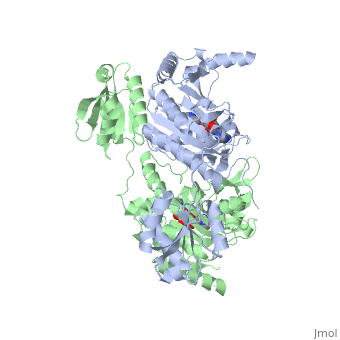User:Jamie Abbott/Sandbox2
From Proteopedia
(→Histidyl-tRNA Synthetase) |
(→Histidyl-tRNA Synthetase) |
||
| Line 5: | Line 5: | ||
'''Histidine Binding Pocket''' | '''Histidine Binding Pocket''' | ||
| - | The active site to HisRS contains a histidine binding pocket composed of highly conserved residues found in distinct sequences motifs. First, the LV/AAGGGLDYY loop (or <scene name='User:Jamie_Abbott/Sandbox2/Hisa_loop/1'>HisA Loop</scene> ) forms one wall of the binding pocket. This HisA loop is highly conserved and extends over a part of the active site<ref name="aaRSbk">Francklyn, C., and Arnez, J.G. (2004) in ''Aminoacyl-tRNA Synthetases'' (Ibba, M.,Francklyn, C.,Cusack, S.. Eds.) [http://www.landesbioscience.com/books/iu/id/810/?nocache=145477703 Landes Publishing, Austin, TX]</ref>. Second, the glycine-rich β-strand (sequence AGGRYDGL preceding <scene name='User:Jamie_Abbott/Sandbox2/Motif_iii/4'>motif III</scene>) comprises the histidine binding pocket floor and wall. Finally, conserved side chains that make direct contact with histidine are Glu83 and Gly127 (<scene name='User:Jamie_Abbott/Sandbox2/Motif_ii/2'>motif II</scene>), which contact the α-amino and α-carbonyl functional groups, respectively, and Glu131 (motif II) and Tyr264, which make hydrogen bonds to the Nδ and Nε, respectively, of the imidazole ring<ref name="aaRSbk" />.</StructureSection> | + | The active site to HisRS contains a histidine binding pocket composed of highly conserved residues found in distinct sequences motifs. First, the LV/AAGGGLDYY loop (or <scene name='User:Jamie_Abbott/Sandbox2/Hisa_loop/1'>HisA Loop</scene> ) forms one wall of the binding pocket. This HisA loop is highly conserved and extends over a part of the active site<ref name="aaRSbk">Francklyn, C., and Arnez, J.G. (2004) in ''Aminoacyl-tRNA Synthetases'' (Ibba, M.,Francklyn, C.,Cusack, S.. Eds.) [http://www.landesbioscience.com/books/iu/id/810/?nocache=145477703 Landes Publishing, Austin, TX]</ref>. Second, the glycine-rich β-strand (sequence AGGRYDGL preceding <scene name='User:Jamie_Abbott/Sandbox2/Motif_iii/4'>motif III</scene>) comprises the histidine binding pocket floor and wall. Finally, conserved side chains that make direct contact with histidine are Glu83 and Gly127 (<scene name='User:Jamie_Abbott/Sandbox2/Motif_ii/2'>motif II</scene>), which contact the α-amino and α-carbonyl functional groups, respectively, and Glu131 (motif II) and Tyr264, which make hydrogen bonds to the Nδ and Nε, respectively, of the imidazole ring<ref name="aaRSbk" />. |
| + | |||
| + | Many interactions are required to prepare ATP for attack by a bound histidine molecule and encourage the magnesium pyrophosphate moiety to act as a leaving group. Residues in the β strands and the loop portion of motif 2 are important in ATP contacts for HisRS<ref name="Arnez97">PMID: 9207058</ref>.</StructureSection> | ||
<scene name='User:Jamie_Abbott/Sandbox2/Hisrsdimer_to_monomer/2'>Monomer</scene> | <scene name='User:Jamie_Abbott/Sandbox2/Hisrsdimer_to_monomer/2'>Monomer</scene> | ||
Revision as of 22:16, 14 April 2012
Contents |
Histidyl-tRNA Synthetase
Histidyl tRNA Synthetase (HisRS) is a 94kD that belongs to the class II of aminoacyl-tRNA synthetases (aaRS). Aminoacyl-tRNA synthetases Aminoacyl-tRNA synthetases have been partitioned into two classes, containing 10 members, on the basis of sequence comparisons[1]. Class I and Class II differ mainly with respect to the topology of the catalytic fold and site of esterification on cognate tRNA[1]. Class II enzymes have a composed of anti-parallel β-sheets and α-helices (residues 1-325). Additionally, class II enzymes can be further divided into three subgroups: class IIa, distinguished by an N-terminal catalytic domain and C-terminal accessory domain (later shown to be anticodon binding domain); class IIb, whose anticodon binding domain is located on the N-terminal side of the fold; and class IIc, encompassing the tetrameric PheRS and GlyRS class II synthetases.[2]
| |||||||||||
Mechanism
Evolutionary Conservation
Structural Homology
3D Structures of Histidyl-tRNA Synthetase
References
- ↑ 1.0 1.1 Eriani G, Delarue M, Poch O, Gangloff J, Moras D. Partition of tRNA synthetases into two classes based on mutually exclusive sets of sequence motifs. Nature. 1990 Sep 13;347(6289):203-6. PMID:2203971 doi:http://dx.doi.org/10.1038/347203a0
- ↑ Cusack S, Hartlein M, Leberman R. Sequence, structural and evolutionary relationships between class 2 aminoacyl-tRNA synthetases. Nucleic Acids Res. 1991 Jul 11;19(13):3489-98. PMID:1852601
- ↑ 3.0 3.1 Francklyn, C., and Arnez, J.G. (2004) in Aminoacyl-tRNA Synthetases (Ibba, M.,Francklyn, C.,Cusack, S.. Eds.) Landes Publishing, Austin, TX
- ↑ Arnez JG, Augustine JG, Moras D, Francklyn CS. The first step of aminoacylation at the atomic level in histidyl-tRNA synthetase. Proc Natl Acad Sci U S A. 1997 Jul 8;94(14):7144-9. PMID:9207058

